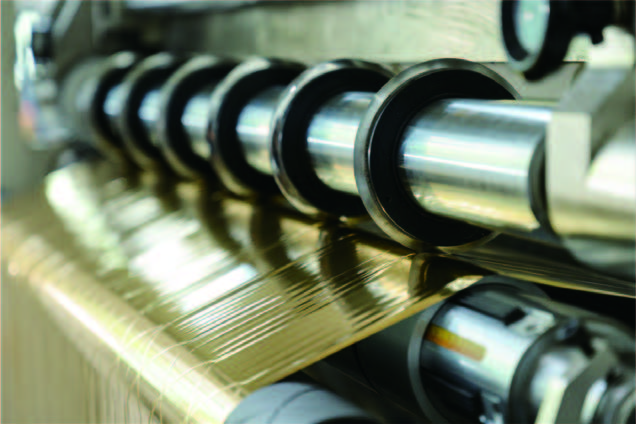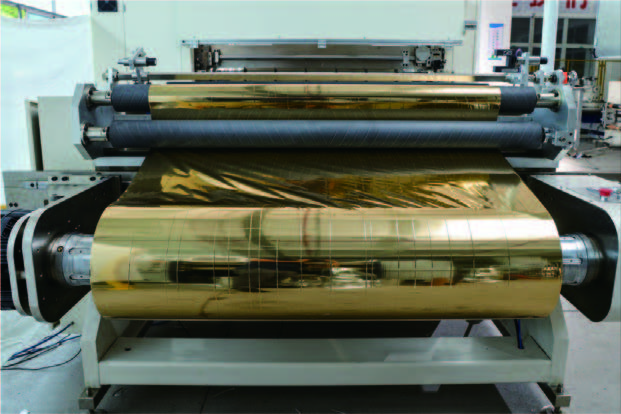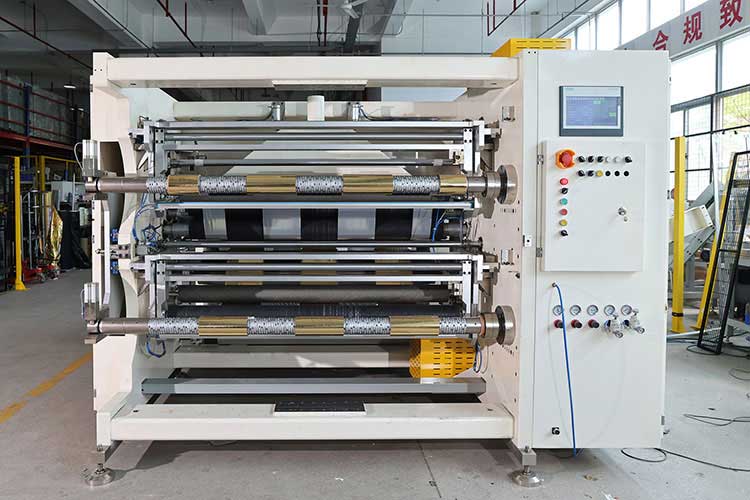Metal foil (copper foil, aluminum foil) slitting is a key link in high-end manufacturing such as new energy batteries and electronic circuits, and has extremely high requirements for the accuracy, cleanliness and stability of the slitting machine. The following are the core technologies and application solutions of slitting machine in metal foil processing:
First, special challenges of metal foil slitting
1. Material properties
• Extremely thin and fragile: The thickness of copper/aluminum foil is usually 6-20μm (even up to 4μm for lithium battery foil), which is prone to wrinkles and scratches.
• High ductility: The metal has strong ductility, and it is easy to produce burrs or curls during slitting.
• Electrostatic sensitivity: metal foil is prone to accumulate static electricity, which adsorbs dust and affects the subsequent coating/lamination process.
2. Process requirements
• Dust-free slitting: The dust particle size of the foil for new energy batteries is required to be ≤0.5μm (such as the slitting of the pole piece of the power battery).
• Zero-defect edges: burr height should be controlled at ≤1μm (to prevent short circuit in the battery).

Second, the key technology of metal foil slitting machine
1. Ultra-precision slitting system
• Tool design
• Nano-level cutting edge round knife: diamond-coated insert (3 times longer life) with a cutting edge arc radius ≤ 0.1μm.
• Air Float Support Turret: Reduces mechanical contact vibration and ensures cutting stability.
• Slitting mode
• Non-contact: laser slitting or ultrasonic slitting to avoid mechanical stress (suitable for 4-6μm ultra-thin foils).
• Rolling slitting: cemented carbide upper and lower knife to roll, pressure closed-loop control (accuracy ±0.01mm).
2. Dynamic control technology
• Multi-axis tension control
◦ Magnetic particle brake + tension sensor in the whole process of unwinding → traction → rewinding, with a fluctuation range of ≤ 0.1N.
◦ Taper tension to prevent sliding between foil layers.
• Real-time web correction system
◦ CCD visual detection of edge position, linkage with EPC correction mechanism (accuracy ±0.03mm).
3. Dust-free and anti-pollution solution
• Fully enclosed clean cabin
◦ Maintains micro-positive pressure internally, equipped with ISO Class 5 HEPA filtration.
• Static Elimination
◦ The combination of ionic air rod + conductive brush makes the electrostatic ≤ of 10V on the surface of the foil (new energy industry standard).
• Debris management
◦ Vacuum adsorption + electrostatic dust collection dual system, dust collection efficiency ≥ 99%.

Third, typical application scenarios
1. Lithium battery copper foil/aluminum foil slitting
• Slitting specification: width 100-800mm (suitable for battery pole piece size), speed 60-150m/min.
• Quality Requirements:
◦ No burrs (SEM detects edge roughness Ra≤0.2 μm).
◦ No oil stain (residue <0.01mg/m²).
2. Foil processing for electronic circuits
• High-frequency copper foil: The dielectric loss needs to be stable after slitting (e.g., RTF copper foil slitting accuracy ±0.02mm).
• EMI shielding aluminum foil: avoid lattice damage during slitting and affect shielding effectiveness.
Fourth, intelligent upgrade scheme
1. AI visual quality inspection
◦ In-line inspection systems (e.g., Keyence laser microscopes) identify defects such as pinholes and cracks in real time.
◦ Deep learning algorithms classify defect types (scratches/oxidation points, etc.), automatically mark them, and provide feedback on process adjustments.
2. Digital Twin Optimization
◦ Predict the impact of slitting parameters (e.g., tool pitch, speed) on quality through virtual commissioning.

Fifth, selection and maintenance suggestions
1. Key points of selection
◦ Ultra-thin foil (<8 μm) preferentially selects laser slitting or suspended mechanical slitting.
◦ Winders need to be equipped with surface defect detection (e.g., eddy current sensors).
2. Maintenance is critical
◦ Clean the knife holder and air duct daily, and check the tension system every week.
◦ The blade needs to be polished (or replaced) every 50 km of slitting.
Metal foil slitting machine is developing in the direction of ultra-thin, zero defect and intelligence, especially driven by the new energy industry, nano-level slitting and online quality inspection technology will become the core of competition.
 Copper foil slitting machine: as light as a wing, slitting without error
Copper foil slitting machine: as light as a wing, slitting without error Copper and aluminum foil slitting machine: perfect cutting of extremely thin metals, casting the "invisible cornerstone" of modern industry
Copper and aluminum foil slitting machine: perfect cutting of extremely thin metals, casting the "invisible cornerstone" of modern industry High-efficiency and energy-saving copper foil slitting machine: reduce energy consumption and green production
High-efficiency and energy-saving copper foil slitting machine: reduce energy consumption and green production Artificial intelligence-based copper foil slitting machine: to achieve intelligent production
Artificial intelligence-based copper foil slitting machine: to achieve intelligent production Analysis of the development trend of the copper foil slitting machine market
Analysis of the development trend of the copper foil slitting machine market